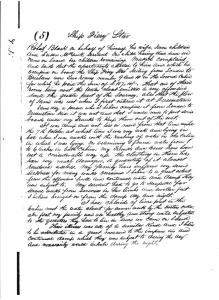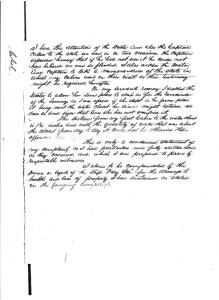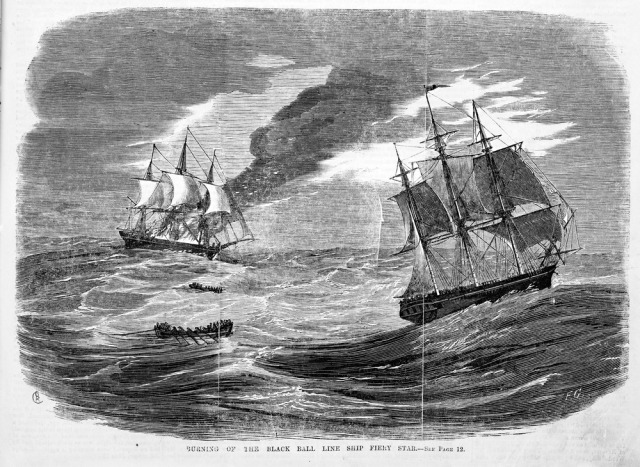This post is part of ‘Upping Sticks: the Black Family‘. If your interest is in the Black family you might want to start there. If not, keep reading.
The Fiery Star
The Fiery Star was a 1360 ton clipper owned by the Black Ball Line (part of James Baines & Co). She was a wooden vessel built in 1851. Originally named Comet, she was purchased by the Black Ball Line in 1863 from Buckton & Crane of New York.
She made two voyages with immigrants to Queensland, Australia from England and Ireland in 1863 and 1864. Rather confusingly both arrived in Moreton Bay, Brisbane on 20 November of their respective years. On both voyages she was captained by W H Yule.
Immigration Companies and Societies
Quite a lot of immigration in the 19th Century was organised by companies or societies who were looking for specific types of immigrants or looking to settle a particular area. The Fiery Star was bringing out immigrants for two of these:
- The Queensland Immigration Society (QIS) attracting mainly Catholic immigrants from the King’s County in Ireland to Brisbane. It had two major promoters – parish priest Father Patrick Dunne and the first Roman Catholic bishop of Queensland James Quinn. Rev. Dunne was onboard the 1863 Fiery Star voyage.
- The Queensland Co-Operative Cotton Growing and Manufacturing Company, established by Charles Bushell and Benjamin Babbage, was targeting unemployed workers from Manchester’s cotton mills.
Were the Black family part of these immigration schemes? There is no documentation as to which of the passengers was sponsored by which group or who was an independent passenger. However, the Black family were neither Catholic nor from Manchester and they paid for their passage, so they were independent passengers.
The 1863 voyage
The Fiery Star left Gravesend on 11 August 1863 having embarked 324 passengers. She picked up another 230 at Queenstown (Cork) which included the Black family. This made a total of 554 – she was chartered to take 470 “statute adults”! So the ship was very overcrowded.
To make unpleasant conditions even worse, she took 94 days to get from Cork to Brisbane instead of around 70. They didn’t have favourable trade winds north of Madeira and east of Brazil, and the final leg up the east coast of Australia was also very slow. Some days they traveled less than 100 miles – to put this in context, their total journey was 17,215 miles!
The only upside is that she seems to have been well supplied. The schedule signed off by Captain Yule on 17 August notes:
I hereby certify that the Provisions actually laden on board this Ship are sufficient, according to the requirement of the Passengers’ Act, for 460 Statute Adults, for a Voyage of 140 days.
They finally arrived on 20 November probably to the relief of all.
The Black family on the Fiery Star
The Black family were second cabin passengers. There were Robert Black, his wife Rachel (nee Greacen), 7 children and their maid Susan McQurke (aged 23). They all gave their nationality as “Scotch” rather than Irish.
Despite being second cabin passengers, Robert and his sons Robert William (15) and Greacen (13) were listed as ‘labourers’ on the passenger list. My Grandad (probably not knowing they traveled in the second cabin) noted that ‘labourer’ was:
a term which probably included farm workers. Since (Robert) transported a large family across the world to Australia and then to NZ, where he at once set up a substantial business, he clearly had much more money that this designation would suggest.
“The mortality was not great, only nine deaths” (Brisbane Courier) which sadly for the Black family, included their youngest daughter Sarah who died at sea on September 22. Dr Luce, the ship’s surgeon records it thus in the voyage newsletter (Sept 26):
I am sorry, however, I cannot close my weekly bulletin without having to record one death amongst our number during the past week, viz., that of an affectionate and most interesting little girl, between two and three years old, the child of our respected and esteemed second-cabin passengers, Mr and Mrs Black. She was taken ill about a fortnight since, with a cold and febrile attack, followed, towards the end of her illness, by inflammation of the lungs, which she sunk under after the most patient endurance of her sufferings (from beginning to end) on Tuesday last. I need scarcely add, that the warmest and sincerest sympathy has been alike felt and expressed for the bereaved parents by all around them, who have the pleasure of their acquaintance: and I am glad to further add, that they sustain their loss with the most exemplary Christian fortitude and submission.
It makes this parent of a small child (currently with a chest infection!) very glad of the discovery of anti-biotics!
It gets sadder with the report of Sarah’s burial at sea in the voyage newsletter:
A melancholy cermonial took place on Tuesday, viz., the burial of an interesting little girl, the daughter of Mr. and Mrs. Black of the second cabin. A burial at sea is a solemn and trying cermony, and has often been described, but no one who has not witnessed it can know the feeling of deep regret with which even a stranger sees the body cosigned to the vasty deep. What then must be the grief of the bereaved parents, around who knees the departed had played or prattled in happier house, and whose tottering footsteps they watched with such anxious hopefulness.
Sarah was one of 9 children who died on the voyage. Somewhat representative of the times, Dr Luce thought this number reasonable given the crowded conditions.
After the voyage
Newspaper articles published after the Fiery Star‘s arrival give the impression that all was well with the journey. There was even a cricket game organised between the saloon passengers and locals (the passengers lost). However, the overcrowding was quickly reported to the Government Immigration Office in Brisbane.
The submission by A C Kemball on 26 November includes a report from Dr Luce and letters of complaint from the passengers (the originals can be found in the Queensland State Archives). These include one from Robert Black:
Robert Black on behalf of himself, his wife, seven children and Susan McGusk, servant. One child having died since we came on board, six children remaining, Maketh complaint and saith that the apartments allotted to him and which he occupied on board the ship “Fiery Star” Sailing from London to Brisban were two rooms number 9 and 10 in the Second Cabin for which he paid the sum of £187.10/- That one of those rooms being next the water closet emitted a very offensive smell the greater part of the journey. Also that the floor of same was wet when I first entered it at Queenstown. Same day a person who I believed occupied it from London to Queenstown said it was wet and that I would need to put some boards under my trunks to keep them out of the wet.
It was damp and wet less or more from that time until the 7th October at which time I was very sick and lying in bed when I was awoke with the rushing of water in the cabin in which I was lying. On examining I found water from 1 to 6 inches in both cabins. My trunks and boxes have been wet a considerable way yup. The clothing in them has been very much damaged. A quantity of it almost rendered useless. My family have suffered very severe sickness for may weeks occasioned I believe to a great extent from the offensive smell and continual water and damp they were subjected to. My servant had to go to Hospital for several weeks from soreness in her limbs and swollen feet I believe brought on from the damp day and night.
I had chloride of lime put in the cabin next the water closet for several weeks by Doctors orders. In fact, my family were all healthy and strong until subjected to the quarters they had to live in since we came on board.
Their illness was all of a similar kind and I believe to be attributed in a great measure to the impure air and continual damp which they were subject to during the day and necessarily would inhale during the night.
I had the attention of the Doctor and also the Captain called to the state we were in on two occasions. The Captain expressed himself that if he had not seen it he cold not have believed we were so flooded. I also asked the Doctor and Captain to take a memorandum of the state in which my cabins were on their visit, as their testimony might be required hereafter.
On my servants recovery I asked the Doctor to allow her some place to sleep in for the remainder of the journey, as I was afraid if she slept in her former place it being near the water closet her disease might return. He don so, and since that time she has not occupied it.
The Distance from my first Cabin to the water closet is 1 3/4 inches and with the quantity of water that was about the closet from day to day it could not be otherwise that offensive and injurious to health.
This is only a condensed statement of my complaints as I have particulars more fully written down as they occurred, and which I am prepared to proved by respectable witnesses.
I claim to be compensated by the owners or agents of the ship “Fiery Star” for the damage to health and loss of property I have sustained as stated in the foregoing complaint.
I don’t know if Robert got any compensation. I do find it strange that Sarah’s death wasn’t mentioned. The conditions sound like they weren’t too good for her either. But it’s likely that it just wasn’t done like that back then.
When I mentioned to my Jackman cousins that the original of this document was in Queensland’s Archives, one said “I’m taking Mum for a holiday there in a few months, I’ll go and have a look”. A few days later he emailed “can’t wait, have sent the nephew down to find it!”. Here it is:
Further Information
Newspaper articles can be found on Trove digitized newspapers (National Library of Australia)
Voyage newsletter – on the National Library of Australia website
“They Came Direct: Immigration Vessels to Queensland: Fiery Star 1863” by Eileen B Johnson
Includes transcripts of many of the documents quoted above.
I found a copy in the State Library of Queensland so check out your local library.
“Out of the frying pan: voyaging to Queensland in 1863 on board the Fiery Star” by Kerry Heckenberg published in the Queensland Review, August 2010.
Contains information from ‘They Came Direct’ and other sources
You can find a copy of this online if you have access to Gale World History in Context site (which you do through Wellington Libraries if you live here in Wellington).
The fate of the Fiery Star
The Fiery Star‘s voyage back to London from Brisbane in 1865 was her last. The 1966 Encyclopedia of New Zealand summarises it in its “Disasters and Mishaps – Shipwrecks” section:
Burning of Fiery Star
The Fiery Star, a full-rigged clipper of 1,361 tons, London-bound from Brisbane, met with misadventure of the worst kind—fire at sea—when 150 miles northwest of the Chatham Islands. Fire broke out in her cargo of wool on 19 April 1865, and a course was set for Hauraki Gulf; but after four days the captain decided to abandon ship. Seventy-eight of her passengers and crew, with Captain W. H. Yule, took to the boats, and were never seen again, but the chief officer and 17 of the crew who stayed behind and fought the flames for nearly three weeks, while at the same time working the ship towards land, were taken off by the ship Dauntless half an hour before the Fiery Star foundered in a mass of flames. They were then only about 15 miles from the New Zealand coast.
This engraving of the burning by Frederick Grosse can be found on the State Library of Victoria’s website. And NZ Bound has a further summation of the information available including the names of the surviving crew.
I have wondered what exactly the Fiery Star was doing off the Chatham Islands which are 680km (420mi) south-east of New Zealand. It would imply they were going around Cape Horn – the Panama Canal didn’t exist at this point. It is noted as being the most hazardous way of getting from Australia to Europe. Not a route I would have picked!
So, if we’ve learnt anything, don’t put the word ‘Fiery’ in the name of your ship! It’s tempting fate.



